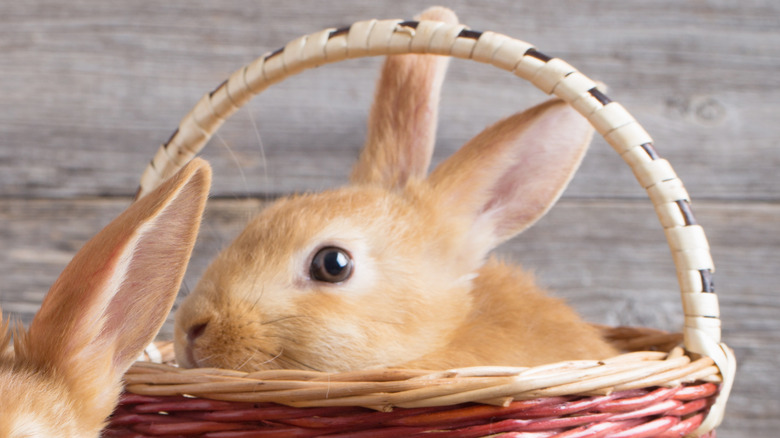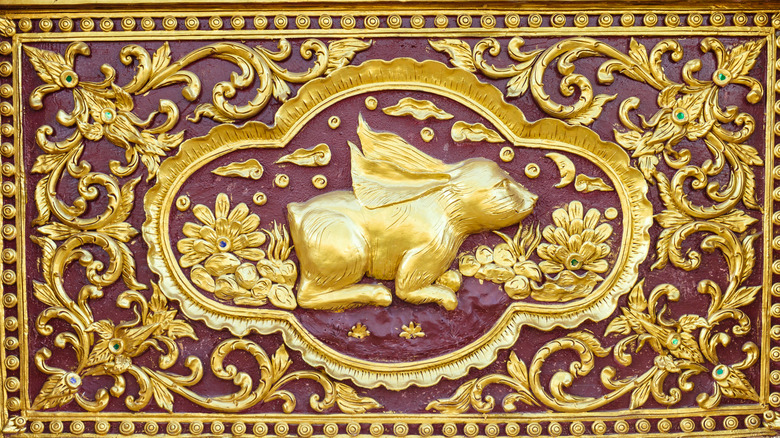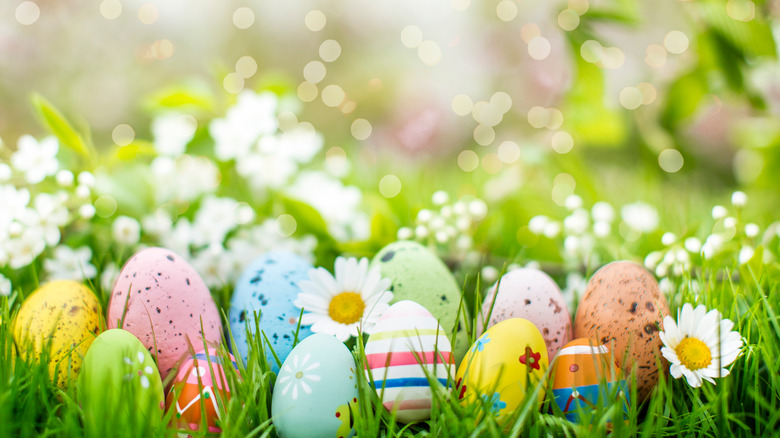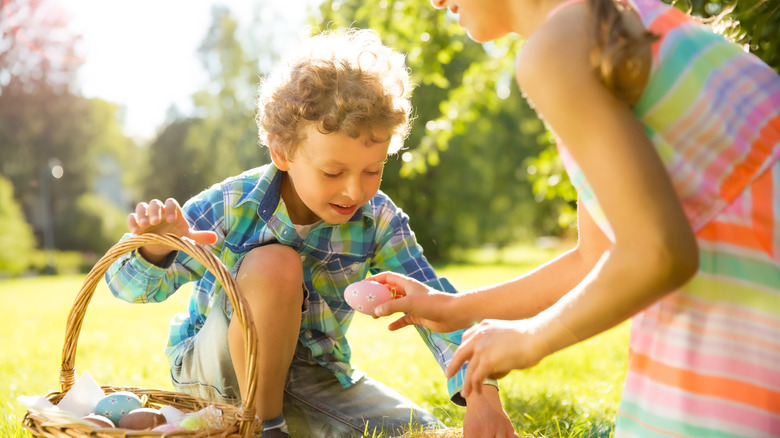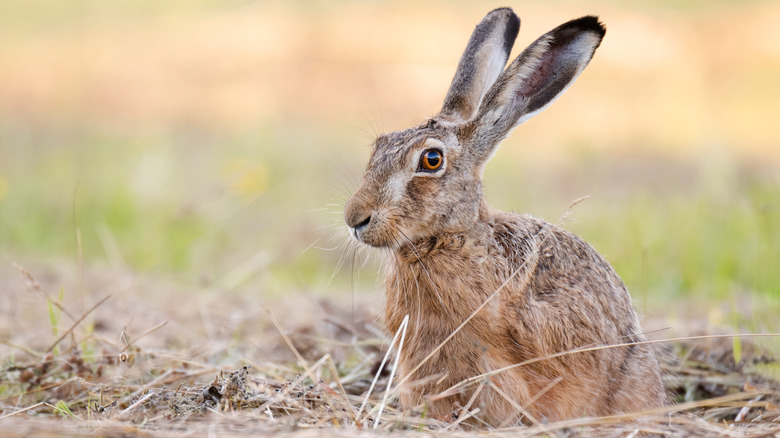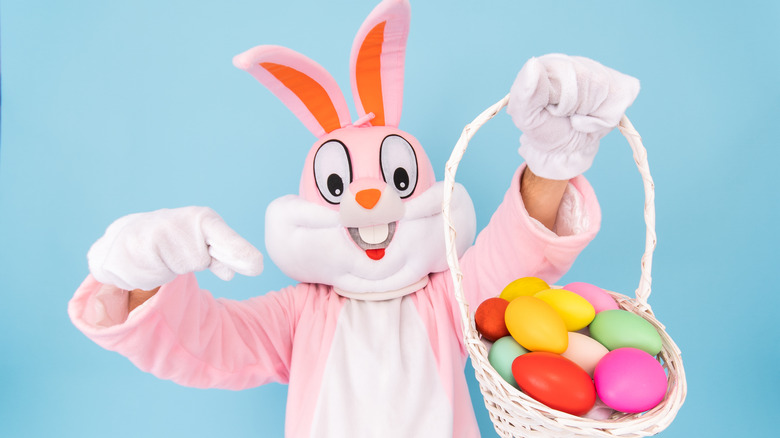The Pagan Origin Of The Easter Bunny Explained
The origin of Easter celebrations can be traced back thousands of years from many traditions. Several ancient cultures, including the Romans, Mayans, and Persians, celebrated the season of new life with the beginning of spring. The Christian celebration of the resurrection of Jesus on Easter also occurs in spring (via Learn Religions).
The word "Easter" is most likely derived from the names of goddesses worshiped in various cultures — Eostre among the Saxons, Ostara by the Teutonic peoples, according to Historic Mysteries. But what about a holiday character like the Easter Bunny? The cute critter is as much a part of the holiday as eggs are, but the notion of a bunny delivering eggs at Easter seems rather odd when you stop and think about it. So, how did such an unusual idea come to be accepted in our culture? It turns out the idea of an Easter Bunny is connected to the celebration of spring, with ties that reach back to German folklore.
The hare and Easter go back centuries
One of the earliest written pieces mentioning an Easter Bunny and eggs is an ancient German text from 1572, in which the author wrote: "Do not worry if the Easter Bunny escapes you; should we miss his eggs, we will cook the nest," per The Conversation. Another text referred to the Easter Bunny as an "old fable," indicating that the story was even older than 1572, but little is known about either of these texts, and even less is known about how the idea of the Easter Bunny came to be.
More recent explanations connect a hare with pagan celebrations of spring. One suggestion involves the festival of Eostre. According to Ancient Origins, Eostre was the goddess of spring and renewal. She was also known as Ostara, Eastre, and Austra. People celebrated the spring equinox because it marked the time of year when the days would have more light than darkness. Ostara, a representation of fertility, was often depicted in works of art with a hare.
How did decorated eggs become part of Easter?
An egg holds new life, so it's not too much of a surprise to see why some pagan cultures chose eggs as a representation of spring. Some ancient societies, such as the Hindus, Persians, and Egyptians, believed that the world came into being from an egg. Christians also see the egg as a representation of the resurrection of Jesus, per Learn Religions.
Decorating eggs is an ancient tradition that dates back centuries. The Ukrainian Museum states that the pastime of decorating eggs, called pysanky, goes back to antiquity in Ukraine. People believed intricately decorated eggs were talismans that would bring them good luck and protect them against evil. Designs on eggs were distinct, based with the sun being the most significant image. Other designs included flowers, trees, leaves, horses, and birds. The colors used in the designs also held special meaning, with red representing the sun, life, and also joy, says the Ukrainian Museum.
How the hare came to lay eggs
We all know hares or rabbits do not lay eggs, so how did this behavior become associated with the Easter Bunny? One explanation is found in the German tale of Ostara. History states that according to folklore, the goddess loved children, and one day to entertain them, she changed her pet bird into a hare. The hare presented her with colored eggs that she gave to the children. Another theory states that Ostara healed a wounded bird by changing it into a hare. The hare, still part bird, presented the goddess with eggs as a sign of gratitude. Another Germanic custom involved a hare called "Osterhase" or "Oschter Haws" that laid colored eggs for children, who built nests in anticipation of the eggs.
The earliest reference to a rabbit delivering eggs is found in a German text dating to 1682. German doctor Johannes Richier wrote a 16-page dissertation on Easter eggs in which he referenced the Osterhase who laid and hid colorful eggs for children on Easter Sunday (via Live Science).
The Easter Bunny evolved from a hare
The Easter Bunny was once an Easter Hare. While these animals look alike, they are different species. According to Britannica, the easiest way to tell the difference between a rabbit and a hare is to look its size. Hares have bigger bodies and larger ears than rabbits do. National Geographic points out that hares live above ground, while rabbits live underground (with the exception of the American cottontail). Rabbits are born with closed eyes and without fur, while hares are fully developed when they are born. Hares are also faster than rabbits. Strangely enough, jackrabbits, technically, are hares.
There is no specific reason or time when the Easter Hare became the Easter Bunny. That said, National Geographic explains that hares are less social than rabbits, which might be one reason why modern cultures decided to go with the more friendly bunny rabbit. That's just a theory; there's no conclusive evidence to support this notion.
How the modern Easter Bunny came to be
While there is no specific date on when the Easter Bunny arrived in the U.S., History reports that some sources trace it back to the 1700s, when German immigrants brought their tradition of the Osterhase with them. The custom of children building nests for the Easter Bunny became popular and spread across the land. Eventually, the hare's gifts moved beyond eggs to include chocolates and other candy. Children stopped building nests for them and turned instead to colorful baskets. Children would also leave carrot treats out for the busy bunny.
The modern Easter Bunny has gained a Santa-like status, and children can visit him at certain events, parades, department stores, or shopping centers as the holiday approaches. There is even a website dedicated to tracking the Easter Bunny as he makes deliveries to good children across the globe, per Track the Easter Bunny.
